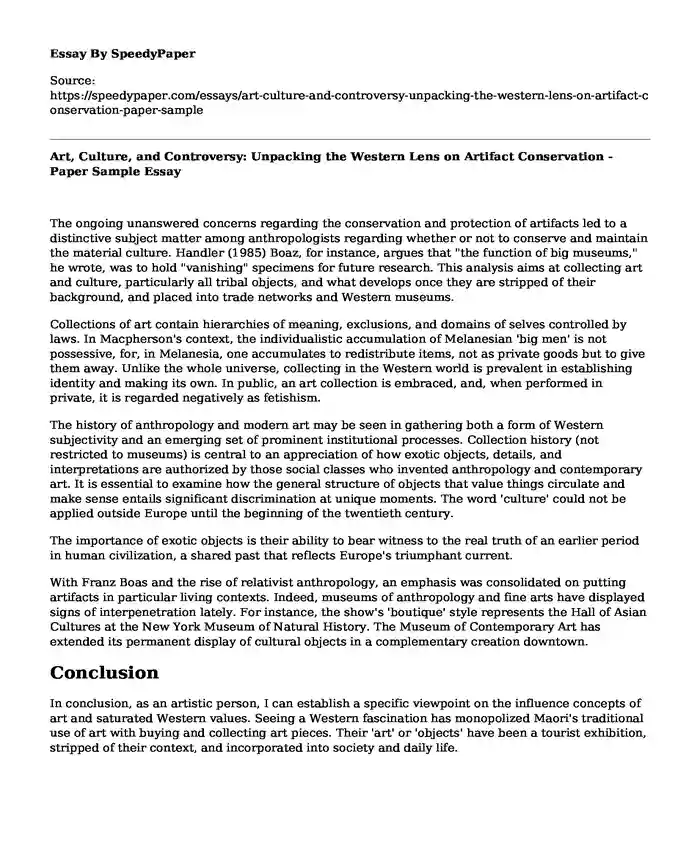The ongoing unanswered concerns regarding the conservation and protection of artifacts led to a distinctive subject matter among anthropologists regarding whether or not to conserve and maintain the material culture. Handler (1985) Boaz, for instance, argues that "the function of big museums," he wrote, was to hold "vanishing" specimens for future research. This analysis aims at collecting art and culture, particularly all tribal objects, and what develops once they are stripped of their background, and placed into trade networks and Western museums.
Collections of art contain hierarchies of meaning, exclusions, and domains of selves controlled by laws. In Macpherson's context, the individualistic accumulation of Melanesian 'big men' is not possessive, for, in Melanesia, one accumulates to redistribute items, not as private goods but to give them away. Unlike the whole universe, collecting in the Western world is prevalent in establishing identity and making its own. In public, an art collection is embraced, and, when performed in private, it is regarded negatively as fetishism.
The history of anthropology and modern art may be seen in gathering both a form of Western subjectivity and an emerging set of prominent institutional processes. Collection history (not restricted to museums) is central to an appreciation of how exotic objects, details, and interpretations are authorized by those social classes who invented anthropology and contemporary art. It is essential to examine how the general structure of objects that value things circulate and make sense entails significant discrimination at unique moments. The word 'culture' could not be applied outside Europe until the beginning of the twentieth century.
The importance of exotic objects is their ability to bear witness to the real truth of an earlier period in human civilization, a shared past that reflects Europe's triumphant current.
With Franz Boas and the rise of relativist anthropology, an emphasis was consolidated on putting artifacts in particular living contexts. Indeed, museums of anthropology and fine arts have displayed signs of interpenetration lately. For instance, the show's 'boutique' style represents the Hall of Asian Cultures at the New York Museum of Natural History. The Museum of Contemporary Art has extended its permanent display of cultural objects in a complementary creation downtown.
Conclusion
In conclusion, as an artistic person, I can establish a specific viewpoint on the influence concepts of art and saturated Western values. Seeing a Western fascination has monopolized Maori's traditional use of art with buying and collecting art pieces. Their 'art' or 'objects' have been a tourist exhibition, stripped of their context, and incorporated into society and daily life.
References
Handler, R. (1985). On having a culture. Objects and others: essays on museums and material culture.
'On collecting art and culture'. (n.d.). critical studies. https://theresacriticalstudies.blogspot.com/2008/07/on-collecting-art-and-culture.html
Cite this page
Art, Culture, and Controversy: Unpacking the Western Lens on Artifact Conservation - Paper Sample. (2023, Dec 20). Retrieved from https://speedypaper.com/essays/art-culture-and-controversy-unpacking-the-western-lens-on-artifact-conservation-paper-sample
Request Removal
If you are the original author of this essay and no longer wish to have it published on the SpeedyPaper website, please click below to request its removal:
- Essay Example on Art Movement and Graphic Design
- Essay Sample: Importance of Vision, Mission, and Code of Ethics for Organizations
- African Music and Culture, Essay Example
- Essay Sample on Gender Stereotype in Children Literature
- Essay Sample on the Music Education in a Time of Cultural Transmission
- Free Essay. Importance of Understanding Clients Within the Context of Their Cultures
- Foundation of Theory of Organization - Free Paper Sample
Popular categories





